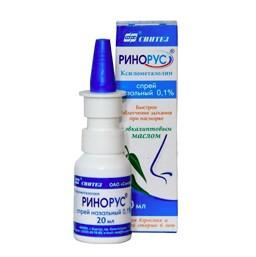Description
eliminating, thus, edema and hyperemia of the mucous membrane of the nasopharynx.
When applied locally to the inflamed mucous membrane of the nasal cavity, it reduces its swelling and concomitant hypersecretion of mucus (discharge from the nose), which facilitates drainage of the nasal passages.
Restores nasal breathing.
Elimination of edema of the mucous membrane of the nasal cavity helps to restore aeration of the paranasal sinuses of the nasal cavity, middle ear cavity, which reduces the likelihood of bacterial complications (sinusitis, sinusitis, otitis media).
When applied topically at therapeutic concentrations, it does not irritate or cause hyperemia of the nasal mucosa.
The drug begins to act quickly, within a few minutes.
Duration of the drug is up to 12 hours.
Indications
– treatment of acute respiratory diseases accompanied by a runny nose
– allergic rhinitis
– vasomotor rhinitis
– to restore drainage in the case of inflammation of the sinuses, eustachitis, otitis media in order to eliminate the diagnosis – for treatment.
Contraindications
– hypersensitivity to the components of the drug
– atrophic (dry) rhinitis
– angle-closure glaucoma
– condition after transsphenoid hypophysectomy
– surgical interventions on the dura mater (s) in children
Precautions
With increased intraocular pressure, chronic heart failure, hypertension, angina pectoris arrhythmias of chronic renal failure in patients with prostatic hyperplasia with clinical symptoms (urinary retention) severe atherosclerosis with hyperthyroidism diabetes mellitus pheochromocytoma tachycardia therapy with monoamine oxidase inhibitors (MAO) (including up to 14 days after their cancellation / during the previous 2 weeks and within 2 weeks after their cancellation) and tricyclic antidepressants, as well as other drugs that increase the blood pressure of porphyria. If you have one or more of the above diseases and conditions, then you must consult your doctor before starting treatment.
Special instructions
Glycerol, which is part of the excipients of Rinostop® Extra, It has the ability to bind and retain water, which contributes to the additional hydration of the nasal mucosa.
Avoid contact with eyes.
To avoid the spread of infection, you must use the drug individually.
Do not exceed the maximum dates and recommended doses for self-administration of the drug.
If there is no decrease or aggravation of the symptoms of the disease, consult a doctor.
Composition
Composition per 1 ml:
Active ingredient:
Oxymethazoline hydrochloride – 0.25 mg.
Excipients:
Citric acid monohydrate – 0.609 mg
sodium citrate dihydrate – 3.823 mg
glycerol – 24.348 mg
benzalkonium chloride – 0.15 mg
purified water – up to 1 ml.
Dosage and Administration
Intranasally.
For children aged 1 to 6 years: 1 injection into each nostril 2-3 times a day.
The drug is used for 5-7 days.
The drug can be reappointed only after a few days.
If symptoms worsen or improvement does not occur within 3 days, consult a doctor.
In the recommended dose, without consulting a doctor, use no more than 7 days.
With frequent and prolonged use of the drug, a feeling of nasal congestion may reappear or worsen.
If these symptoms occur, discontinue treatment and consult a doctor.
Side effects
Classification of the frequency of side effects (WHO): very often (with a frequency of more than 1/10), often (with a frequency of at least 1/100, but less than 1/10), infrequently (with a frequency of at least 1 / 1000, but less than 1/100), rarely (with a frequency of at least 1/10000, but less than 1/1000), very rarely (with a frequency of less than 1/10000, including individual messages), the frequency is unknown (cannot be determined from the available data).
Immune system disorders:
Infrequently: hypersensitivity reactions (angioedema, exanthema, pruritus).
Disorders of the gastrointestinal tract:
Rarely: nausea.
Disorders of the nervous system:
Rarely: headache, dizziness, anxiety, irritability, sleep disturbance (in children), insomnia.
Very rare: fatigue, drowsiness, restlessness, hallucinations, cramps.
Heart disorders:
Rarely: high blood pressure, palpitations, tachycardia.
Disorders of the respiratory system, chest and mediastinal organs:
Infrequently: burning or dryness of the mucous membranes of the nasal cavity, sneezing, nose bleed.
In rare cases: after the effect of using the drug passes, a feeling of nasal congestion (reactive hyperemia). Very rare: respiratory arrest (in infants).
Visual disturbances:
Rarely: visual impairment (in contact with eyes).
Prolonged continuous use of vasoconstrictor drugs can lead to tachyphylaxis, atrophy of the nasal mucosa and recurrent edema of the nasal mucosa (drug rhinitis).
If any of the side effects indicated in the instructions are aggravated or you notice any other side effects not listed in the instructions, notify your doctor
Overdose
The clinical signs of intoxication with imidazole derivatives can be nonspecific and unclear, since the phases of hyperactivity are replaced by phases of inhibition of the central nervous system, cardiovascular and respiratory systems.
Symptoms: anxiety, anxiety, hallucinations, cramps, lowering body temperature, lethargy, drowsiness, coma, narrowing or dilated pupils, fever, sweating, pallor, cyanosis, palpitations, bradycardia, arrhythmia, cardiac arrest, increased blood pressure, decreased blood pressure, nausea, vomiting, respiratory depression, respiratory arrest.
In children, an overdose can cause the development of symptoms from the central nervous system, such as: agitation, convulsions, coma, bradycardia, respiratory arrest, as well as increased blood pressure, followed by a possible decrease in blood pressure.
Treatment: gastric lavage, intake of activated carbon (in case of accidental ingestion of the drug inside) is symptomatic.
In severe overdose, intensive care is indicated in a hospital setting.
The use of vasoconstrictors is contraindicated.
In case of overdose, consult a doctor.
Storage conditions
Store at a temperature not exceeding 25 ° С.
Keep out of the reach of children
Expiration
2 years.
Do not use after expiration date.
Deystvuyuschee substances
oxymetazoline
Conditions of release from drugstores
Without prescription
dosage form
nasal spray



